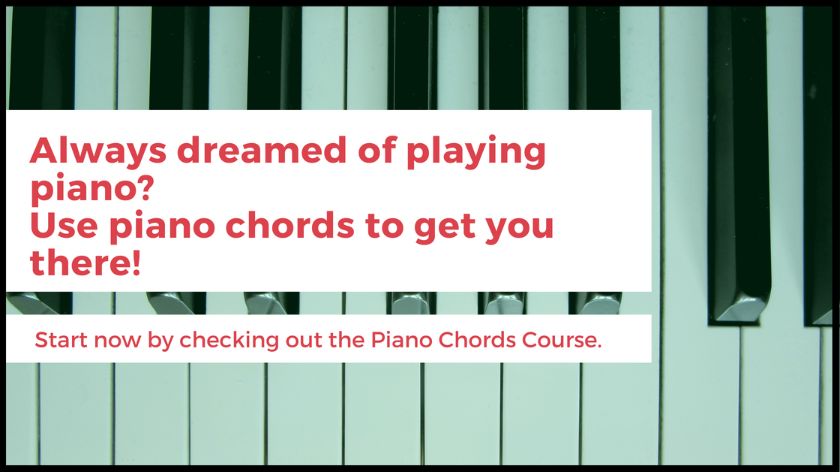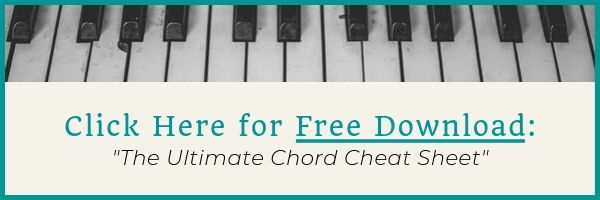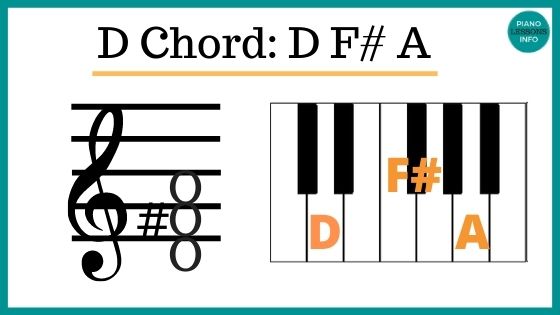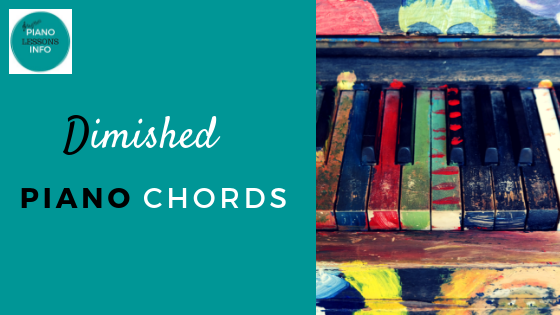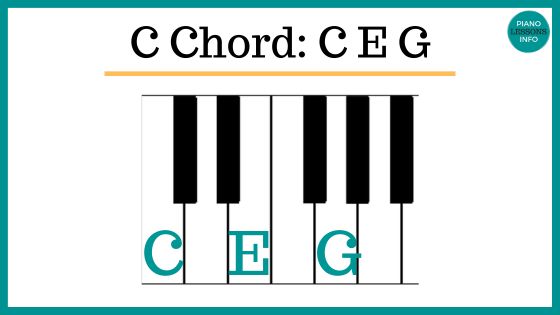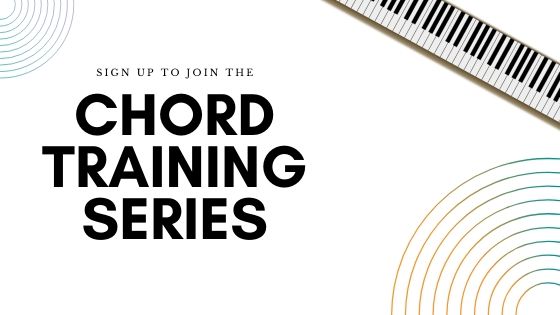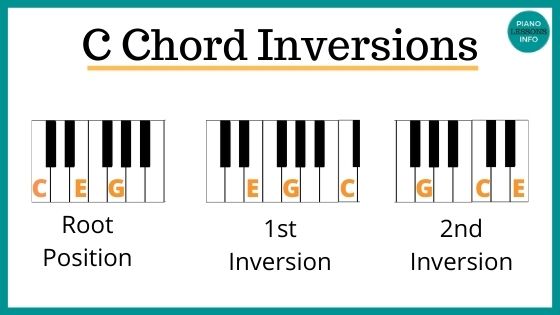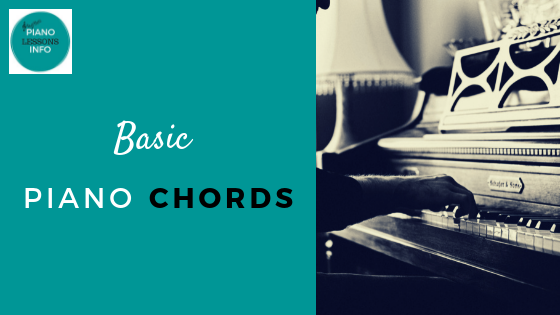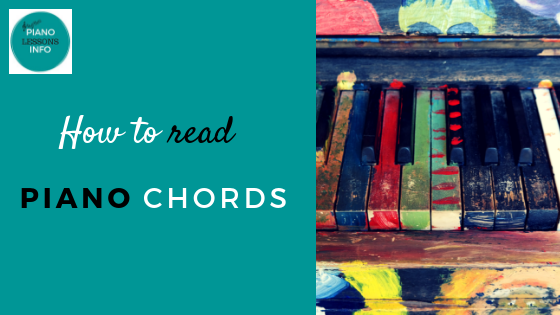Piano Chord Theory Guide
You know what chords are, now you just need some piano chords theory. There are a couple of ways to approach figuring out piano chords theory. I think the simplest and best way to learn the theory is based on key signatures.
A key signature tells you how many sharps or flats are in a key. You can use them to play scales. For chords, we only need to be aware of the key signatures for the major scales. (Click here for a list of the key signatures.)

To play a scale, you start on a specific note and end on the same one - only higher or lower. On the notes in between, you play according to the musical alphabet (ABCDEFG). You have to keep in mind the key signature. Some notes will need a sharp or a flat. Knowing scales are helpful for piano chords theory.
Chords are essentially notes piled on top of each other. In order to know what the chord is, you need to know what key the chord is in and what the symbol means.
Keep in mind that the first letter in the chord is the root. It’s the note that you’ll build the other notes from. If the letter is followed by a sharp or a flat, it’s included as part of the root.
Here are the nuts and bolts of piano chords theory: the types of chords and their make-up.
Major Chord
Example: G
This chord is written as just a letter name. Like C or D or F# or Bb. It’s the simplest chord. To make it you use the 1st, 3rd, and 5th notes of the scale. Understanding the major chord makes the rest piano chords theory easier.
The C chord is easy because there are no sharps or flats. You just play C E G. For other chords like D, you need to be aware of the key signature. The first note is D and the second is F# because D has a key signature of F# and C#. If you played only an F, it would make a minor chord. The whole chord is D F# A.
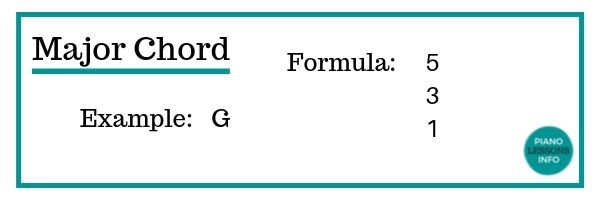
Minor Chord
Example: c#m
It is similar to a major chord only you must lower the middle note of the chord. This note is the 3rd note of the scale. In a cm chord, E is lowered to Eb.
Lowering is an important part of piano chords theory. It means you must make the note lower by a semi-tone or half step. On the piano it usually means going from a white key down to the closest black key (except for C and F) or a black key down to the next lowest white key. D becomes Db, F# becomes F, and C becomes B (but called Cb).
Any time you see a small “m”, it means to lower the third note of the scale. This applies for any chord with a small m. For example, dm7, dm, dmM7, dm6, etc.
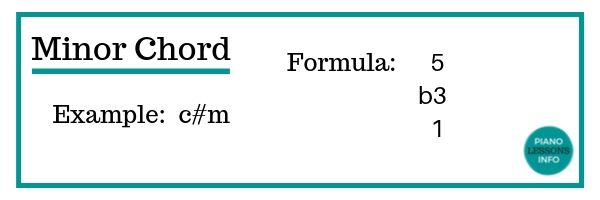
7th Chord
Example: G7
In a 7th chord, you are playing 4 notes. The 1st, 3rd, 5th, and 7th notes of the scale. You must lower the 7th note by one semi-tone or a half step. (Lowering was explained above in minor chords.) This is true for chords that look like these: C7, Cm7, Csus7.
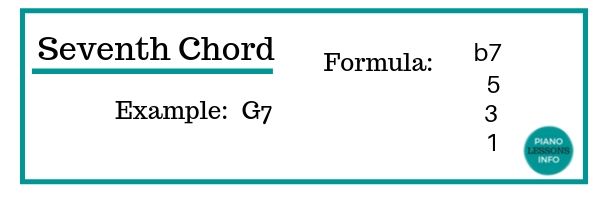
Major 7th Chord
Example: AM7, Amaj7
For a major 7th chord, you do not lower the 7th note. The big “M” is telling you not to do that. Play it according to its key signature. You just play the 1st, 3rd, 5th, and 7th notes of the scale.
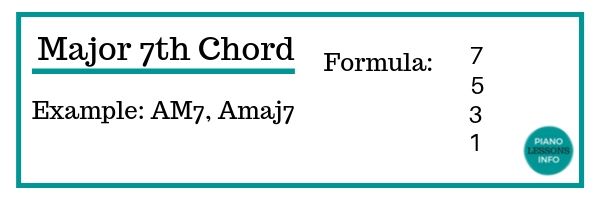
Minor 7th Chord
Example: am7
This chord is a combination of the minor chord and the 7th chord. Because of the small “m”, you lower the 3rd note of the scale. Because of the 7th, you lower the 7th note of the scale. The chord then is made up of the 1st, lowered 3rd, 5th, and lowered 7th notes of the scale.
Now for a quick review of the piano chords theory you've learned so far. Let’s look at the chord gm7. The root is G and so we think about the key signature. G has F#. That means we’re thinking about the notes G B D F#. But, a small “m” means to lower the 3rd note of the scale. So we have G Bb D F#. The 7 means to lower the 7th note of the scale. F# to F. So that means we have a chord with the notes G Bb D F.
Suspended Chord
Example: Esus, E4, Esus4
This is a chord that sounds like it’s unfinished or unresolved. It doesn’t include the 3rd note of the scale. It’s been replaced by the 4th note of the scale.
Altogether, you play the 1st, 4th, and 5th notes of the scale. For a Gsus or G4, the notes are G (no B) C D.
This chord can be written differently also. These are the usuals: Fsus, F4, or Fsus4.
Click here for more on suspended chords.
Suspended 7th Chord
Example: Fsus7
In a suspended 7th chord, you play the 4th note of the scale instead of the 3rd note. Also, you play the lowered 7th as described above in 7th chords. Altogether, you play the 1st, 4th, 5th, and lowered 7th notes of the scale. Asus7 = A D E G.
More information on the suspended 7th chord can be found on the suspended chords page here.
6th Chord
Example: G6
A 6th chord is a 4 note chord. You play the major chord (1st, 3rd, and 5th notes of the scale) plus you add the 6th note of the scale. Always keep in mind the key signature.
A minor 6th or m6 chord means that you lower the 3rd note. If you want to lower the 6th note, you should write a flat symbol before the 6. For example: Cmb6.
2nd Chord
Example: C#2
A 2nd chord is also a 4 note chord. You play the major chord plus the second chord of the scale. That is the 1st, 2nd, 3rd, and 5th notes of the scale. So, A2 is A B C# E.
If you don’t want to include the 3rd note of the scale, you make a suspended 2nd chord. For example: Gsus2. It’s made from the 1st, 2nd, and 5th notes of the scale. Gsus2 = G A D.
A Chord with a bass note
Example: G/D, E7/A, cm7/G
It can be confusing to run into a chord like this: C/D. What this means is play a C chord with a D as the bass note. So maybe in your right hand you are playing a C chord and in your left you are playing a D. The lowest note you play on the piano should be the one that comes after the “/”.
Diminished and Augmented Chords
Example: Cdim
Example: Caug or Cx
Diminished and augmented chords can cause a little “hiccup” when you run into them. They are not very common so when you come across them, it takes some thinking to figure out what they are. When you know piano chords theory, they won't phase you.
In a diminished chord, you play the 1st , lowered 3rd, and lowered 5th notes of the scale. Lowering again means that you make the note go down by one semi-tone or half-step. For a Cdim chord, you play: C Eb Gb.
An augmented chord is almost the opposite. The 1st and 3rd notes stay the same as a major chord. The difference is in the 5th note. This time you raise the 5th note of the scale by one semi-tone or half-step. The major chord of C is CEG and the augmented chord is CEG#. Augmented chords can be written as Caug or Cx.
Okay, now you have some basic piano chords theory. It takes a little time to become really familiar with chords and how to make them. Choose a couple of types to start playing around with. Make your own chord progression to start practicing them.
Listening can also help you to make chords. It can enhance what piano chords theory you've learned. Start with the example listed under one type of chord. Next make another one starting on a different note. Make sure that they sound the same as each other. You can start on any note to begin building a chord.
I always recommend taking a course on chords in order to fully understand piano chords theory. The only one we recommend is Power Piano Chords. It teaches chords from the basics to advanced progressions. You'll really get a handle on the theory. Learning piano chords theory really makes playing chords so much easier.
Free Download:
Ultimate Chord Cheat Sheet

Subscribe below and get free access to the (printable) Ultimate Chord Cheat Sheet.
Recent Articles
-
Piano Notes Chart
Nov 20, 23 10:21 PM
Find a piano notes chart for treble clef and bass clef notes as well as the different types of notes. -
D Chord on Piano + Diagram, How To & Theory
Oct 24, 23 12:20 AM
Learn how to play the D chord on piano with diagram, fingering, D/A, D/F# and a theory explainer. -
Diminished Piano Chords: Chart & How to Make Them
Oct 09, 23 09:23 PM
Learn the different diminished piano chords and how to make them. Here you'll find both a diminished chord chart and an explanation.
Free Download:
Ultimate Chord Cheat Sheet

Subscribe below and get free access to the (printable) Ultimate Chord Cheat Sheet.

